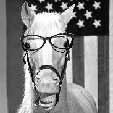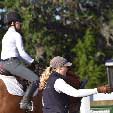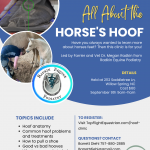
Worry Less, Ride More!

Over 20 years of experience in horse riding, competing, training, barn management, and riding psychology.

Keep up with the latest news, competition updates, and informative articles.

All your questions answered about lessons for you, training for your horse, and other services offered.
Hello Friend!
Let’s Learn!
- Land Rover Kentucky 3-day EventBelow is all the information for the Land Rover Kentucky 3 day Event. Last year 4 of us went and it was a blast. Let me know if …
- Hoof Clinic with Dr. Megan RadkinRegister for the hoof clinic here
Let’s Connect!

Signup for the monthly newsletter below!
Let’s Keep in Touch!
This message is only visible to admins.
Problem displaying Facebook posts. Backup cache in use.
Click to show error
Problem displaying Facebook posts. Backup cache in use.
Click to show error
Error: Error validating access token: The session has been invalidated because the user changed their password or Facebook has changed the session for security reasons. Type: OAuthException
This message is only visible to admins.
Problem displaying Facebook posts. Backup cache in use.
Click to show error
Problem displaying Facebook posts. Backup cache in use.
Click to show error
Error: Error validating access token: The session has been invalidated because the user changed their password or Facebook has changed the session for security reasons. Type: OAuthException
I audited the Doug Payne in house clinic on Saturday and it was wonderful! I hope he has more! Unfortunately, I could only stay for the morning but here are some of the things he talked about in the groups I saw:![]()
![]() Think lower leg forward. The last thing we want to do is get in front.
Think lower leg forward. The last thing we want to do is get in front. ![]() Practice getting left behind. You're not going to fall off backwards. Let her jump out in front of you. The moment you commit with your shoulders at the base then you're totally at her whim on whether the jump is going to happen or not. As she jumps, imagine your hip goes forward as the first thing, not your shoulders.
Practice getting left behind. You're not going to fall off backwards. Let her jump out in front of you. The moment you commit with your shoulders at the base then you're totally at her whim on whether the jump is going to happen or not. As she jumps, imagine your hip goes forward as the first thing, not your shoulders. ![]()
![]() Mid-flight over the jump you want to imagine that you're going to be able to open your hip angle so that you can influence what happens the moment you land. Because if you land forward, you've got two steps where you're not able to do a whole lot.
Mid-flight over the jump you want to imagine that you're going to be able to open your hip angle so that you can influence what happens the moment you land. Because if you land forward, you've got two steps where you're not able to do a whole lot. ![]()
![]() If a horse stops imagine you you can extend the plane of the jump indefinitely on either side. Whenever they try to stop, try not to ever let them pass that plane of the jump, because if you do then it then there is no repercussion at all for the jump. They could just drop the shoulder and go around each time.
If a horse stops imagine you you can extend the plane of the jump indefinitely on either side. Whenever they try to stop, try not to ever let them pass that plane of the jump, because if you do then it then there is no repercussion at all for the jump. They could just drop the shoulder and go around each time.![]()
![]() I probably jump 80% of my jumps with my left two fingers in the martingale strap. The reason being it keeps your hands forward. If I turned into a pansy, and start thinking about pulling it reminds me not to. You've got to be able to keep your shoulders back, but if you have a finger hooked in, it'll make sure your hands stay low. That's the only pitfall of getting shoulders back is that it often changes the angle in your elbow and the hands get high, but if your fingers are in the strap it keeps them low.
I probably jump 80% of my jumps with my left two fingers in the martingale strap. The reason being it keeps your hands forward. If I turned into a pansy, and start thinking about pulling it reminds me not to. You've got to be able to keep your shoulders back, but if you have a finger hooked in, it'll make sure your hands stay low. That's the only pitfall of getting shoulders back is that it often changes the angle in your elbow and the hands get high, but if your fingers are in the strap it keeps them low.![]()
![]() I'll walk or envision courses backwards first. To start at the last jump and say, how do I best get to the last fence? Especially on cross country where you walk a combination that's ABCD and the last element is the one that requires accuracy like a corner or skinny. So I start there and say, how is my line going to make it easiest to jump that last fence.
I'll walk or envision courses backwards first. To start at the last jump and say, how do I best get to the last fence? Especially on cross country where you walk a combination that's ABCD and the last element is the one that requires accuracy like a corner or skinny. So I start there and say, how is my line going to make it easiest to jump that last fence. ![]()
![]() If there's a loud environment, you're going to have to elevate your aids to reach that level. Just like if I'm talking to you in a quiet room vs we're in the middle of a Restaurant - if the ambient noise is quite loud, you're going to have to talk louder just for me to hear you. You're going to have to use stronger aids than you would typically at a normal situation at home for the same desired output. Don't be afraid that when the surroundings and the atmosphere are elevated to just be a little bit stronger. He's got to hear you. Oftentimes, if you stay on the quieter side of what would be typically useful at home he’s going to be overwhelmed by his surroundings and you're never going to get through to him. But the moment that you're there, you say to him look, this is what we're doing and this is how it's got to happen and then he's going to tend to snap into the line of focus, and you can start to back everything off. He's going to start to refocus with you using lighter aids, but don't be afraid in that first couple minutes to be strong to get through.
If there's a loud environment, you're going to have to elevate your aids to reach that level. Just like if I'm talking to you in a quiet room vs we're in the middle of a Restaurant - if the ambient noise is quite loud, you're going to have to talk louder just for me to hear you. You're going to have to use stronger aids than you would typically at a normal situation at home for the same desired output. Don't be afraid that when the surroundings and the atmosphere are elevated to just be a little bit stronger. He's got to hear you. Oftentimes, if you stay on the quieter side of what would be typically useful at home he’s going to be overwhelmed by his surroundings and you're never going to get through to him. But the moment that you're there, you say to him look, this is what we're doing and this is how it's got to happen and then he's going to tend to snap into the line of focus, and you can start to back everything off. He's going to start to refocus with you using lighter aids, but don't be afraid in that first couple minutes to be strong to get through. ![]()
![]() On the first approach to a very spooky jump (in this case a black Liverpool with water in it under an oxer) come at it with some pace because if they look at it you still have that momentum to carry them forward, but on the second approach I would ride it just as strong if not stronger because he knows it's there. The first time you can sometimes catch them by surprise, and you could just get there and make happen, but not so much the second time. I've been dropped more off on the second attempt. Once they have gone over it well several times you are going to slow down and you're just going to go nice and easy and pop up and over it. In the end they're going to learn best when they're in their quietest state.
On the first approach to a very spooky jump (in this case a black Liverpool with water in it under an oxer) come at it with some pace because if they look at it you still have that momentum to carry them forward, but on the second approach I would ride it just as strong if not stronger because he knows it's there. The first time you can sometimes catch them by surprise, and you could just get there and make happen, but not so much the second time. I've been dropped more off on the second attempt. Once they have gone over it well several times you are going to slow down and you're just going to go nice and easy and pop up and over it. In the end they're going to learn best when they're in their quietest state.

